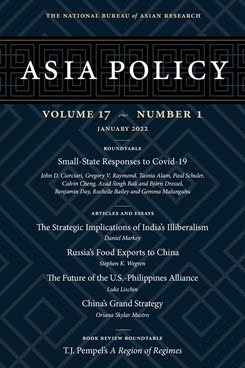Opportunities and Obstacles for Russia’s Food Exports to China
Within the context of expanded economic ties, this article analyzes Russia-China agricultural trade, examining China’s role in Russia’s quest to achieve $45 billion in food exports by 2030 and exploring opportunities for and obstacles to expanded food trade between these two states.
EXECUTIVE SUMMARY
MAIN ARGUMENT
This article develops three principal arguments. First, there are impediments to expanded bilateral agri-food trade that result from governmental restrictions, bureaucratic regulations, and both supply- and demand-side factors. Russia’s main food exports to China (fish and seafood) are limited by environmental standards and international agreed-on limits on wild catch. Pork exports are constrained by Chinese government restrictions that reflect the prioritization of national interests over expanded trade. A second argument is that although the level of bilateral food trade is currently low, there are opportunities for expansion. In principle, Russia could increase export revenue through greater sales of soybeans, poultry, and wheat. That said, the first two commodities are restrained by supply on the Russian side and the third by Chinese restrictions. Third, China inevitably will play a significant role in Russia’s quest to achieve $45 billion in food exports. After Moscow’s 2014 countersanctions against the European Union, China has replaced the EU as Russia’s primary food export market, and the target for exports to China that Russia’s Ministry of Agriculture has set seems too modest.
POLICY IMPLICATIONS
- Continued non-tariff restrictions on trade and other forms of protectionism by both Russia and China suppress food trade. Improved political relations have not been able to overcome elements of trade protectionism.
- Russia will not challenge the U.S. market share for soybean sales to China anytime soon. Although Chinese demand for soybeans is immense, Russia will likely continue to account for a negligible size of market share, even if its near-term production goals are met.
- Increased food trade can deepen and strengthen the Russia-China bilateral relationship in general, although at present trade remains constrained by political, bureaucratic, and economic factors.
Stephen K. Wegren is a Distinguished University Professor and Professor of Political Science at Southern Methodist University in Dallas, Texas (United States). His most recent books are Russia’s Food Revolution: The Transformation of the Food System (2021) and Russia’s Role in the Contemporary International Agri-Food Trade System (2022).
About Asia Policy
Asia Policy is a peer-reviewed scholarly journal presenting policy-relevant academic research on the Asia-Pacific that draws clear and concise conclusions useful to today’s policymakers. Asia Policy is published quarterly in January, April, July, and October and accepts submissions on a rolling basis. Learn more


